Comforter
Is It Ok to Vacuum Pack a Down Comforter
Avoid vacuum packing a down comforter as it can harm the delicate feathers, impacting warmth and longevity – discover better storage options.
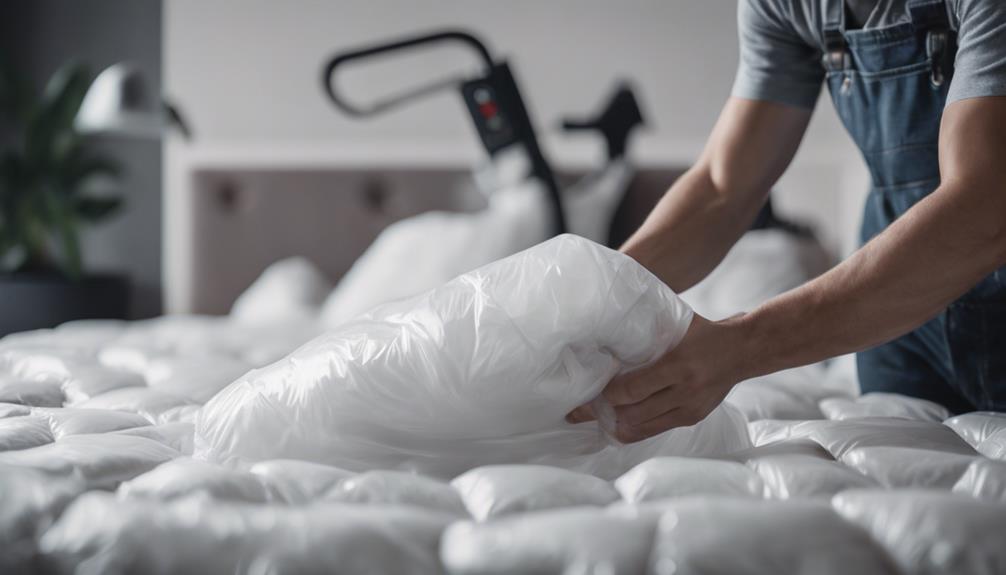
Vacuum sealing a down comforter can potentially harm the delicate feathers, putting the loft at risk, causing clumping, and decreasing insulation efficiency. Compressing it may result in uneven distribution and compromised warmth retention. It’s best to steer clear of vacuum storage bags for down comforters to maintain their quality and longevity. Instead, opt for non-compressing storage solutions to preserve the fluffiness and optimal warmth of your comforter. Consider using breathable storage options such as cotton bags to prevent damage to the delicate feathers and ensure even warmth distribution. Learn more about properly caring for your down comforter for lasting comfort and quality.
Key Takeaways
- Vacuum packing can damage delicate feathers and reduce the loft and insulation of a down comforter.
- Compression can cause feathers to clump together, leading to uneven distribution and reduced warmth retention.
- Avoid vacuum packing to preserve the durability, fluffiness, and overall quality of the comforter.
- Brittle quills in feathers can snap under pressure, affecting the comforter's longevity and insulation.
- Opt for breathable storage solutions like cotton bags to maintain the optimal warmth and loft of a down comforter.
Potential Damage to Down Comforter
When vacuum packing a down comforter, it's important to be aware of the potential damage that can occur to the delicate feathers. Feather duvets are particularly vulnerable to harm when compressed in vacuum storage bags. The brittle quills in full feathers can easily snap under pressure, leading to a loss of loft and insulation in the bedding.
Additionally, squashing the tiny feathers in a down comforter can greatly reduce their effectiveness in retaining warmth. Using vacuum storage bags for down comforters may cause them to become lumpy and lose their fluffiness over time.
To preserve the quality and insulation properties of your feather duvet, it's best to avoid using storage bags that compress the feathers too tightly. Opting for breathable storage solutions that allow the down comforter to retain its natural loft and texture is essential in maintaining its comfort and longevity.
Impact on Fluffiness and Insulation
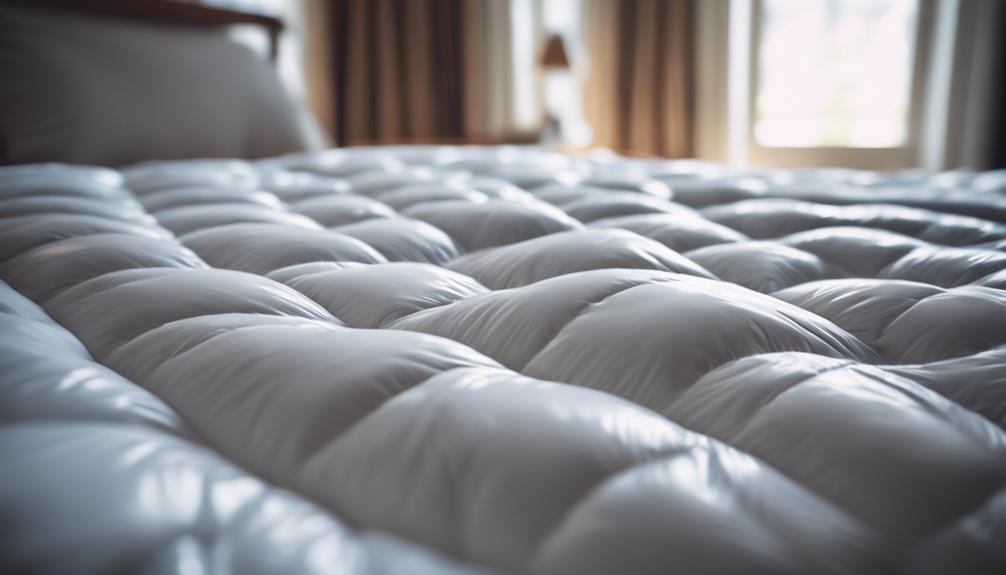
To maintain the fluffiness and insulation of a down comforter, guaranteeing vacuum packing is essential. When we compress feather duvets in vacuum bags, we risk damaging the delicate down feathers that provide warmth and coziness.
The compression from vacuum storage can cause the feathers to clump together, leading to a lumpy and uneven distribution within the comforter. This uneven distribution can result in certain areas being thinner and less insulating than others.
Over time, the repeated compression from vacuum packing can diminish the comforter's ability to trap heat effectively, reducing its overall fluffiness and insulation. To safeguard that your down comforter remains fluffy and retains its insulating properties, it's best to opt for non-compressing storage solutions that allow the feathers to remain lofty and airy.
Longevity and Quality Concerns
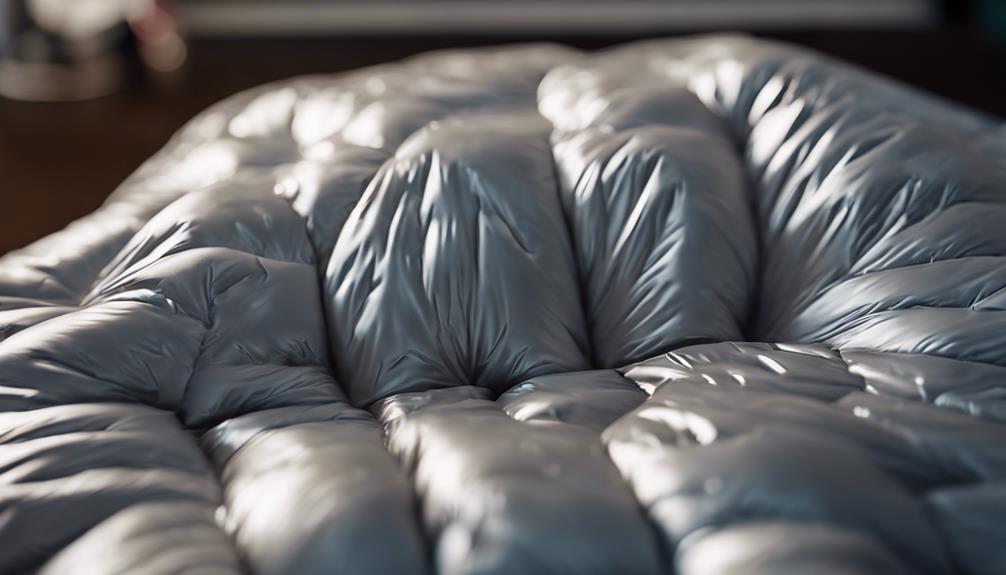
When vacuum packing a down comforter, it's crucial to take into account the potential impacts on longevity and quality. Compression from vacuum storage bags can lead to clumping of feathers and reduced loft, affecting the durability of the comforter.
Restricting airflow by vacuum packing may compromise the insulation properties, ultimately decreasing warmth and comfort.
Durability of Down
The longevity and quality of down bedding can be compromised when subjected to vacuum packing, as the delicate feathers may lose their fluffiness and insulation effectiveness. When full feathers in down comforters are compressed, their brittle quills can snap, affecting durability. Vacuuming down bedding can squash the tiny feathers that provide warmth, reducing insulation effectiveness. Additionally, feather duvets may develop lumps when vacuum packed, impacting their long-term quality and comfort. This damage to the delicate feathers can result in down bedding losing its fluffiness and warmth when vacuum sealed, ultimately affecting its longevity. It is advisable to avoid using vacuum storage bags for down comforters to prevent potential harm to the delicate feathers.
| Durability of Down | |
|---|---|
| Brittle Quills | Affect Durability |
| Reduced Insulation | Decreased Warmth |
| Lumps Formation | Decreased Comfort |
| Loss of Fluffiness | Reduced Longevity |
Impact on Fluffiness
Maintaining the fluffiness of a down comforter is essential for ensuring its longevity and quality. When vacuum packing a down comforter, the compression can damage the delicate feathers, impacting its ability to provide warmth and comfort.
Over time, the squashing of these tiny feathers may lead to lumps and uneven distribution within the comforter, affecting its overall fluffiness. This reduction in fluffiness not only diminishes the comforter's effectiveness but also shortens its lifespan.
To preserve the loftiness and quality of a down comforter, it's advisable to avoid vacuum packing and instead opt for breathable storage solutions that allow the comforter to retain its natural fluffiness and insulation properties without compromising on storage space.
Recommended Storage Methods
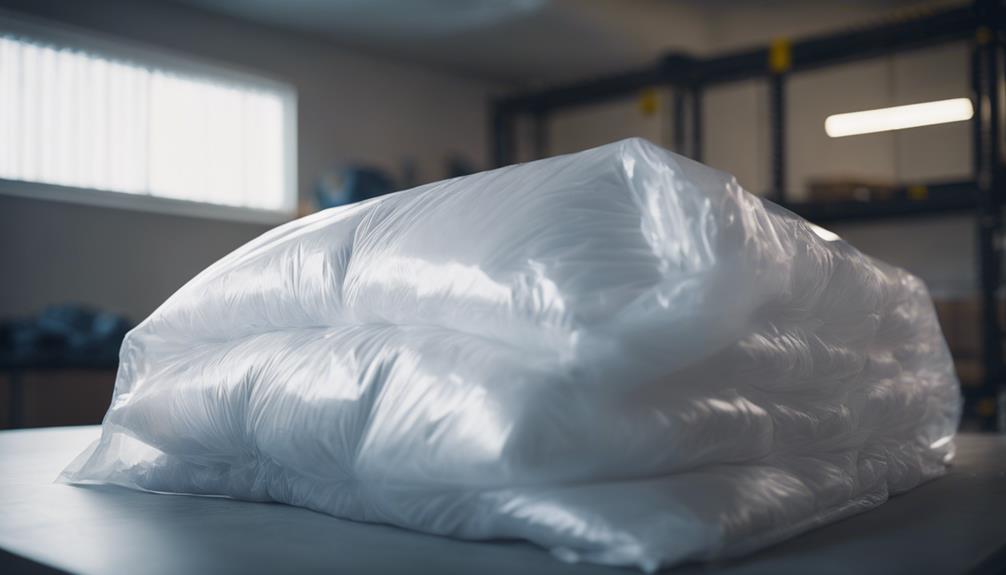
When storing a down comforter, it's crucial to use a large cotton bag to protect the feathers and prevent compression.
Avoid placing heavy objects on top of the comforter to maintain its fluffiness.
Proper Storage Conditions
For best preservation, consider storing down comforters in a breathable cotton bag to prevent feather damage and maintain loftiness. You can also use vacuum-sealed bags for synthetic or down alternative comforters, ensuring they are clean and dry before sealing. Here is a helpful table outlining proper storage conditions:
| Proper Storage Conditions | Description |
|---|---|
| Use a Cotton Bag | Prevents feather damage |
| Avoid Compression | Maintains loftiness |
| No Items on Top | Preserves fluffiness |
| Shake and Fluff After Storage | Re-ventilates down filling |
| Vacuum-Sealed Bags | For clean and dry comforters |
Following these storage methods will help maintain the quality and effectiveness of your down comforter.
Space-Saving Options
One space-saving option that can be considered is utilizing vacuum-sealed bags for down alternative comforters. These bags help reduce the size of the comforter by removing excess air, making it easier to store in tight spaces.
However, it's important to use bags specifically designed for bedding to prevent compression that can damage the fluffiness of the comforter.
Another option is to store the comforter in a plastic bag or acid-free box, ensuring it's clean and completely dry before storage to prevent mildew. Avoid storing down comforters in humid areas, as moisture can lead to mold growth.
Remember to follow the manufacturer's instructions and avoid compressing the comforter in a washing machine for long-term preservation.
Long-Term Preservation Tips
To maintain the quality and effectiveness of feather or down bedding, consider utilizing a large cotton storage bag. Avoid using vacuum storage bags for down bedding, as they can compress the feathers and reduce fluffiness and warmth.
Direct sunlight should be avoided when storing bedding, as it can cause damage over time. Additionally, storing bedding in a cool, dry place is vital to prevent mildew and unpleasant odors. Neusu's non-compressing storage bags are a good option for delicate bedding materials.
When vacuum packing bedding, make sure to leave 20-30% of air inside the bag to prevent damage. Proper storage of feather or down bedding is essential for long-term preservation and maintaining its quality.
Effects on Down Cluster Integrity
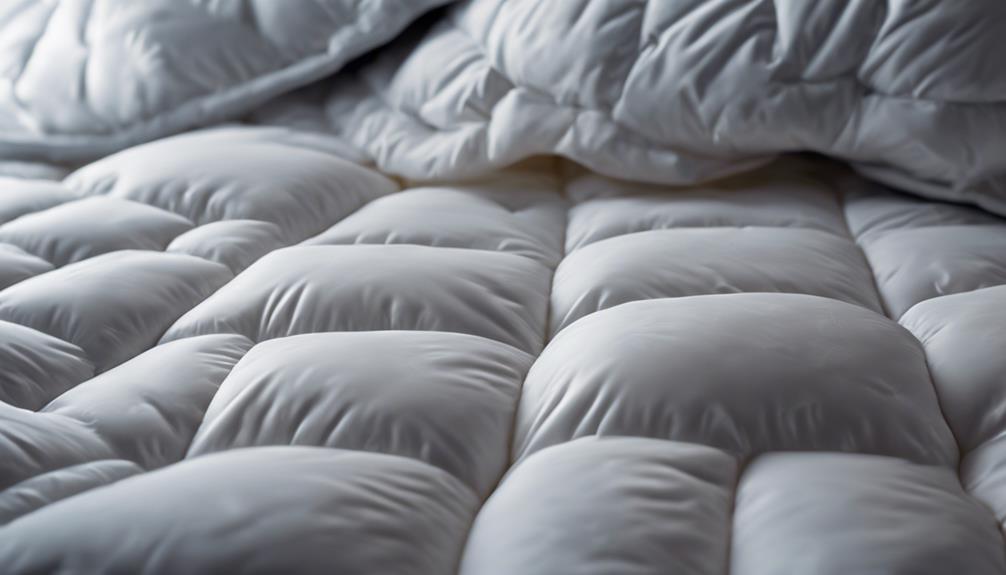
When vacuum packing a down comforter, the ideal performance of down clusters can be compromised, affecting their insulation properties. Down feathers are designed to trap air and provide warmth. However, the compression caused by vacuum sealing can damage these clusters, reducing their ability to keep you warm. To illustrate this further, let's consider the impact of vacuum packing on down clusters:
| Effect | Description | Outcome |
|---|---|---|
| Compression Damage | Squashes down clusters, impacting insulation | Reduced warmth |
| Clumping | Clusters stick together, losing fluffiness over time | Decreased loftiness |
| Structural Integrity Loss | Down feathers lose their natural shape and loft | Diminished insulation effectiveness |
| Long-Term Impact | Continual vacuuming can worsen these effects | Decreased comfort and warmth over time |
To maintain the ideal performance of your down comforter, avoid vacuum packing it and instead use breathable storage options to preserve its integrity and keep you cozy.
Preserving Optimal Warmth and Loft
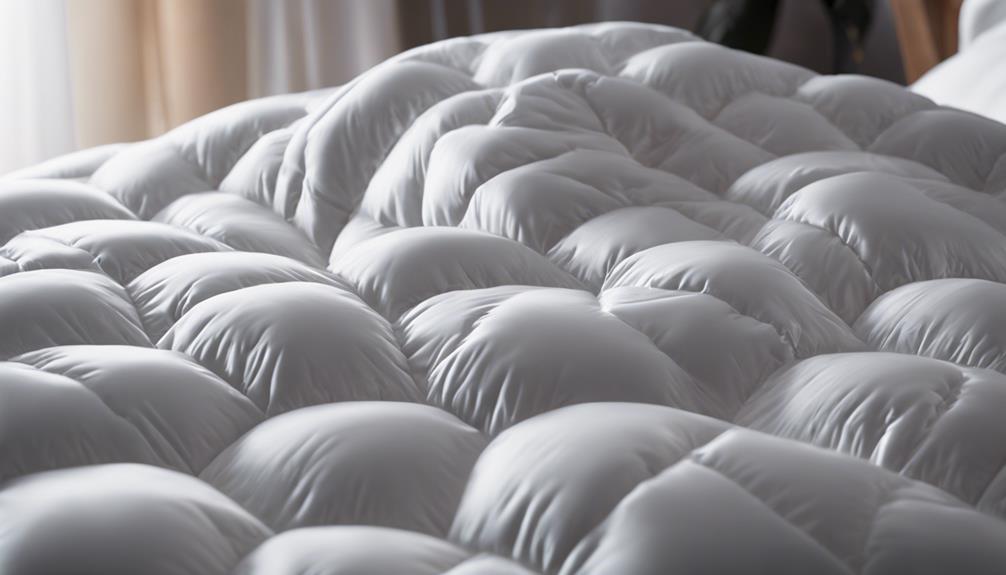
Preserving ideal warmth and loft in a down comforter involves avoiding vacuum packing, which can compress the feathers and diminish their insulation properties. When down clusters are compressed, their ability to trap air and provide warmth is compromised.
To maintain the fluffy and effective nature of a down comforter, it's best to stay away from vacuum packing and choose breathable storage solutions like cotton bags. These storage methods help prevent the delicate down clusters from clumping together and guarantee an even distribution of warmth.
Frequently Asked Questions
Can You Vacuum Bag a Down Comforter?
Yes, vacuum bagging a down comforter isn't recommended. It can harm the delicate feathers, reducing fluffiness and warmth.
The compression can break brittle quills and flatten the insulating tiny feathers, affecting its effectiveness. Lumping may occur, diminishing comfort and quality.
To maintain loftiness and longevity, avoid vacuum storage bags for down comforters. It's best to preserve these cozy essentials without sacrificing their quality and coziness.
Is It Okay to Vacuum Pack a Puffer Jacket?
Vacuum packing a puffer jacket can harm its insulation by compressing the fibers, reducing warmth and causing clumping. It's best to avoid vacuum packing to maintain the jacket's effectiveness.
Opt for proper storage methods like hanging or folding loosely instead.
What Is the Best Way to Store a Down Comforter?
Storing a down comforter properly is key to maintaining its quality. To store it well, use a large cotton bag to prevent feather damage and avoid placing heavy items on top.
After storage, shake and fluff the comforter to keep it fluffy. Remember not to vacuum pack it, as this can damage the feathers.
Consider using non-compressing storage bags like those from Neusu for safe and effective storage.
Can You Vacuum Pack Down a Sleeping Bag?
Vacuum packing a down sleeping bag can damage the delicate down insulation and reduce its loft and warmth. It's important to avoid compressing down items to maintain their effectiveness. Opt for non-compressing storage bags instead.
Proper storage methods are essential for preserving the quality of down sleeping bags. Remember, maintaining loft is key for best insulation.
Can Vacuum Packing Damage My Ugg Comforter?
Vacuum packing can potentially damage your Ugg comforter, especially if it is not stored properly. While washing the Ugg comforter in a machine is not recommended, vacuum packing can compress the fibers and affect the overall fluffiness and insulation of the comforter. It’s best to store it in a breathable bag instead.
Conclusion
In conclusion, vacuum packing a down comforter can potentially damage its fluffiness, insulation, and overall quality. It may compromise the integrity of the down clusters, leading to a decrease in warmth and loft over time.
To preserve your comforter's optimal performance, it's recommended to store it in a breathable cotton storage bag or large pillowcase instead. Remember, proper storage is key to keeping your down comforter cozy and comfortable for years to come.
Mason – Your Product Expert Mason is your go-to product expert, carefully selecting each item in our collection to ensure it meets your comfort, functionality, and style needs. With his attention to detail and commitment to quality, he ensures that every product we offer enhances your home experience.
Comforter
How Much Does It Cost to Have a Down Comforter Dry Cleaned
Always wondered about the cost of having your down comforter dry cleaned? Keep reading to uncover the surprising factors influencing the price.
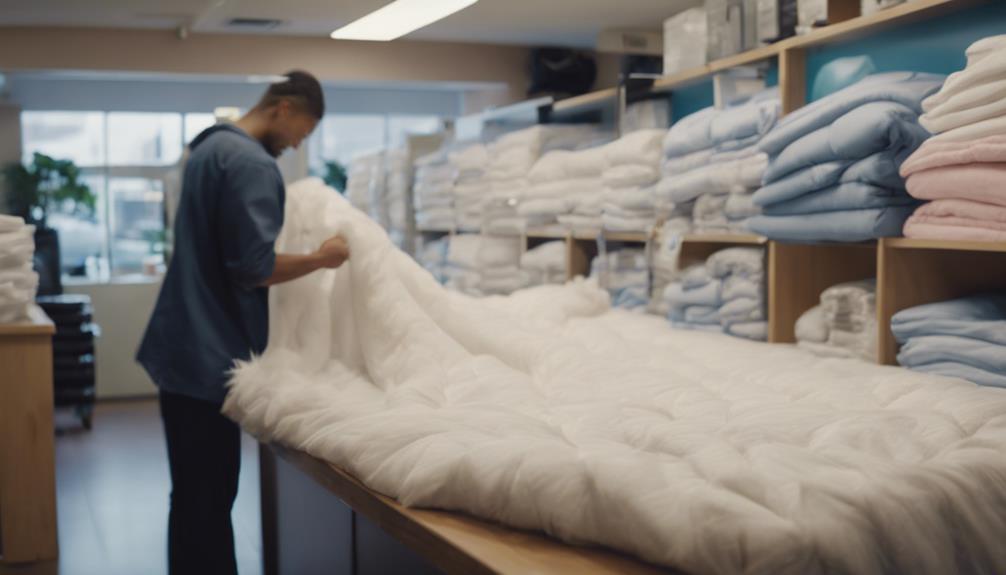
When you take a down comforter to be dry cleaned, you can expect to pay between $30 and $50. King size comforters may be more expensive due to additional materials and labor. Additional charges may apply for special fabrics or damages. The cost can vary depending on cleaning supplies, labor, service, taxes, and optional repairs such as mending holes. Factors that affect pricing include size, fabric, equipment, location of the dry cleaner, as well as the type and condition of the comforter. To find ways to save on dry cleaning or to learn more about do-it-yourself cleaning versus professional services, consider further exploration.
Key Takeaways
- Cost ranges from $30 to $50, with larger sizes costing more due to increased material and labor.
- Additional charges may apply for delicate or damaged fabrics, requiring extra time and attention.
- Factors affecting cost include size, materials, equipment, location, and extra services like mending holes.
- Save on expenses with membership discounts, at-home cleaning kits, and washing machine-friendly options.
- DIY cleaning requires machine washable confirmation, gentle detergent, and thorough drying to prevent damage.
Dry Cleaning Cost Breakdown
When contemplating the cost of dry cleaning a down comforter, understanding the breakdown of expenses is essential. The cost for dry cleaning a down comforter can range from $30 to $50, depending on the size.
Larger sizes, like king size comforters, tend to be on the higher end of this range due to the increased material and labor required. Delicate fabrics and damaged materials may also incur additional costs as they necessitate special care during the dry cleaning process. These extra charges are often associated with the extra time and attention needed to properly clean and preserve these delicate fabrics.
Factors such as cleaning supplies, labor, service, and taxes all play a role in determining the final cost of dry cleaning a down comforter. Additionally, extra services like mending holes can add to the overall expense, making it crucial to take into account all these factors when estimating the total cost.
Factors Affecting Dry Cleaning Cost
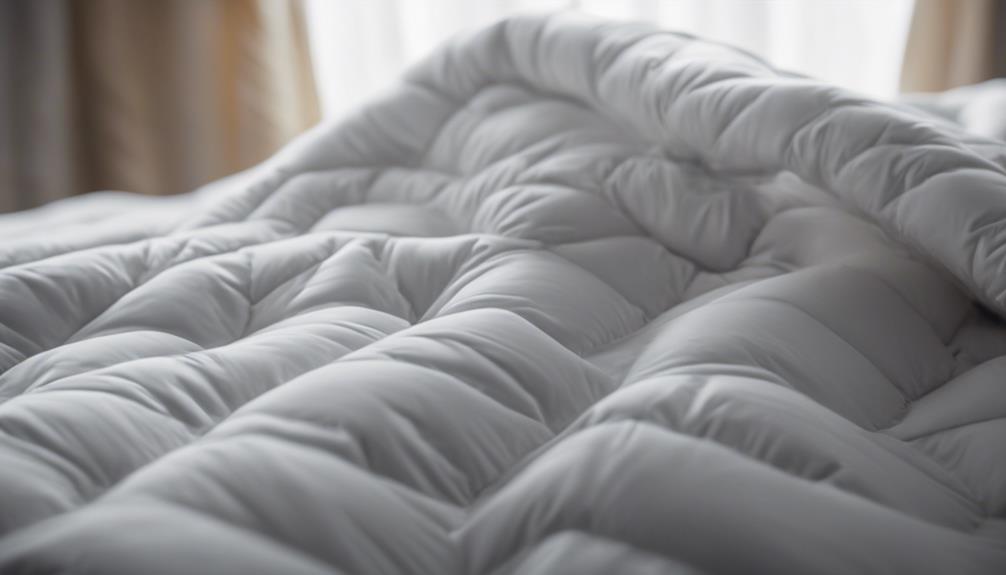
Factors that impact the cost of dry cleaning a down comforter include the size of the comforter, the materials used, the cleaning equipment, and the location of the dry cleaner. Larger comforter sizes, delicate fabrics that require special care, damaged fabric that needs extra attention, modern cleaning machines used for high-quality cleaning, and being in a high standard living area can all influence the final cost of dry cleaning.
To reduce the cost of dry cleaning, consider using washing machine-friendly bedding that can be cleaned at home, utilizing specialized DIY cleaning kits for certain fabrics, seeking discounts as a regular customer, and exploring alternatives that don't require dry cleaning. By being mindful of these factors and taking proactive steps to manage the cleaning process, you can potentially lower the overall expenses associated with keeping your down comforter fresh and clean.
Saving on Dry Cleaning Expenses
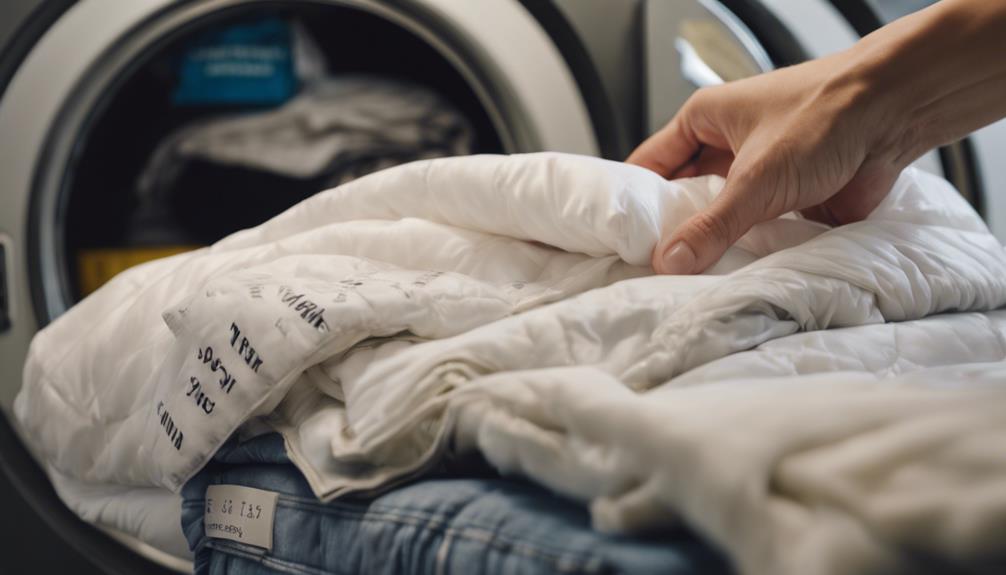
To save on dry cleaning expenses for a down comforter, exploring membership services or seeking regular customer discounts can be beneficial. Many dry cleaners offer discounts or loyalty programs for repeat customers, which can help lower the cost of getting your down comforter cleaned. By taking advantage of these savings opportunities, you can make the process more affordable.
Additionally, considering alternatives like using at-home DIY cleaning kits or opting for bedding that doesn't require dry cleaning can also help you save money in the long run. These alternatives can be cost-effective solutions to keep your down comforter clean without the need for professional dry cleaning services.
When looking to cut down on the cost of dry cleaning your down comforter, it's worth exploring different options and discounts available from dry cleaners to find the best savings for your specific needs.
DIY Vs Professional Cleaning
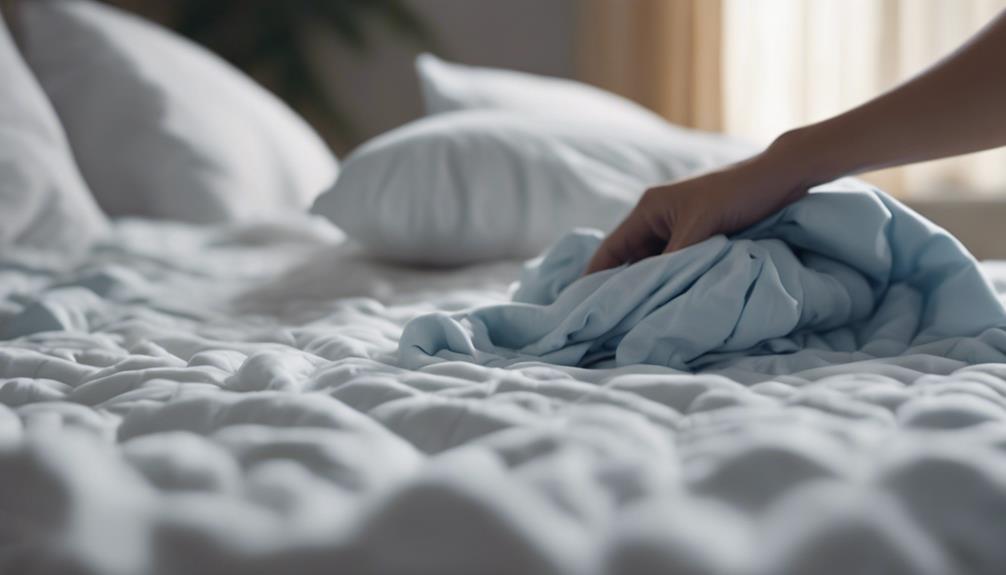
Exploring the choice between DIY and professional cleaning for down comforters is crucial for cost-saving considerations and maintenance effectiveness. Here are some key points to ponder:
- Machine Washable: Confirm your comforter is machine washable before attempting to clean it at home to avoid damaging the delicate down filling.
- Proper Care: Follow care instructions carefully, use a gentle detergent, and wash on a low heat setting to prevent clumping of the down.
- Dry Completely: After washing, make sure the comforter is thoroughly dried to prevent mold and mildew growth.
- Harsh Chemicals: Avoid using harsh chemicals when cleaning a down comforter at home, as they can damage the filling and affect its fluffiness.
While DIY cleaning can be cost-effective, professional laundering may be worth the investment to ensure proper care and maintenance of your down comforter without the risk of damage from incorrect cleaning methods.
Tips for Storing Down Comforters
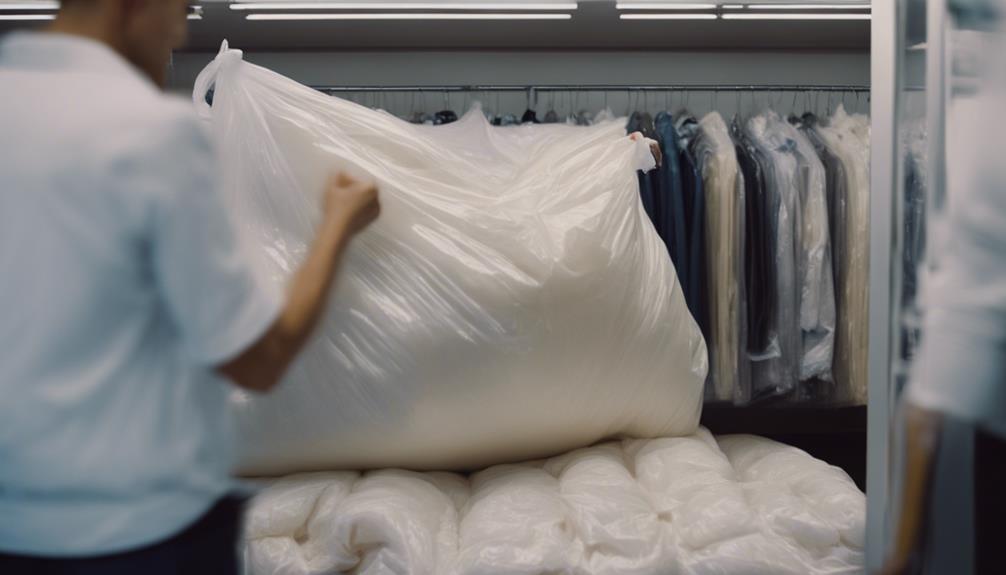
Implementing proper storage techniques is essential for maintaining the quality and longevity of your down comforter.
To store your comforter correctly, use a breathable cloth bag to prevent moisture buildup and odors. Avoid compressing the comforter during storage to keep its fluffiness and loft intact.
When taking it out of storage, give the comforter a good shake to restore its loft and fluffiness. Implement regular care routines such as shaking, washing duvet covers, and spot cleaning to make sure your down comforter stays in top condition.
Storing the comforter in a breathable cloth bag during off-seasons is important to prevent moisture buildup and maintain its quality. By following these tips, you can prolong the lifespan of your down comforter and enjoy its warmth and comfort for years to come.
Frequently Asked Questions
Should I Take My Down Comforter to the Dry Cleaners?
We recommend taking your down comforter to the dry cleaners if it needs a thorough cleaning. It can cost between $30 to $50, depending on the size.
Not all cleaners offer this service, so it's best to check beforehand. Dry cleaning can help prevent shrinkage, but it may expose the down to harsh chemicals.
It's a convenient option if time is a concern, but using a duvet cover can reduce the need for frequent cleanings.
How Expensive Is It to Dry Clean a Down Comforter?
Dry cleaning a down comforter can range from $30 to $50, depending on its size. Additional fees may apply for repairs or special treatments. Costs include supplies, labor, services, and taxes, which vary by location and material. Larger comforters like king size may cost more.
Opting for home washing can be cheaper, depending on care instructions.
How Do You Wash a Down Comforter That Says Dry Clean Only?
If a down comforter is labeled 'dry clean only,' it's best to follow those instructions to prevent damage.
While washing at home can be risky, professional laundering is recommended to avoid harsh chemical damage.
Costs for dry cleaning a down comforter typically range from $30 to $50 depending on size.
Not all dry cleaners provide this service, so it's wise to inquire first.
Following care label instructions is essential to maintain the comforter's quality.
How Often Should You Clean a Down Comforter?
Cleaning a down comforter is crucial for maintaining its quality. With a duvet cover, aim for every 3-5 years; without one, clean every 1-2 years. Spot clean stains to prolong time between washes.
Daily fluffing helps maintain loftiness and even distribution of down. Store it in a breathable cloth bag during off-seasons to prevent odors. Proper care extends its lifespan and guarantees cozy nights for years to come.
What Factors Contribute to the Cost of Dry Cleaning a Down Comforter?
When considering the down comforter dry cleaning cost, several factors play a role. The size of the comforter, the materials used, and any special treatments required all impact the overall cost. Additionally, the location and reputation of the dry cleaner can also affect the final price.
Conclusion
To summarize, the cost of dry cleaning a down comforter can vary depending on factors such as size, material, and location. By understanding these factors and exploring options for saving on expenses, individuals can make informed decisions about how to care for their comforters.
Whether choosing to DIY or seek professional cleaning services, it's important to follow proper storage techniques to guarantee the longevity and quality of the comforter.
Mason – Your Product Expert Mason is your go-to product expert, carefully selecting each item in our collection to ensure it meets your comfort, functionality, and style needs. With his attention to detail and commitment to quality, he ensures that every product we offer enhances your home experience.
Comforter
Where Can I Donate Comforter
Need a place to donate your comforter? Look no further for tips on where to donate and make a difference.

When giving away comforters, think about the American Red Cross, Salvation Army, and Goodwill for gently used items. Make sure they are in good condition. Churches, homeless shelters, and animal shelters also appreciate comforter donations to assist those in need. Local community centers are another good choice. Please refrain from donating heavily damaged comforters or mattresses. Look for drop-off locations or pick-up services for your convenience. Your donation could greatly help provide warmth and comfort. Other alternatives include environmental recycling programs for used textiles. Explore different ways to help those in need. More opportunities are available to expand your generosity.
Key Takeaways
- American Red Cross, GreenDrop, Salvation Army, and Goodwill accept gently used comforters.
- Check with local churches, homeless shelters, and animal shelters for donation opportunities.
- Utilize waste management services or recycling programs for eco-friendly disposal.
- Support community centers by donating comforters to help those in need in the local area.
- Consider organizing donation drives with businesses or organizations to amplify the impact of your donation.
Nationwide Donation Centers
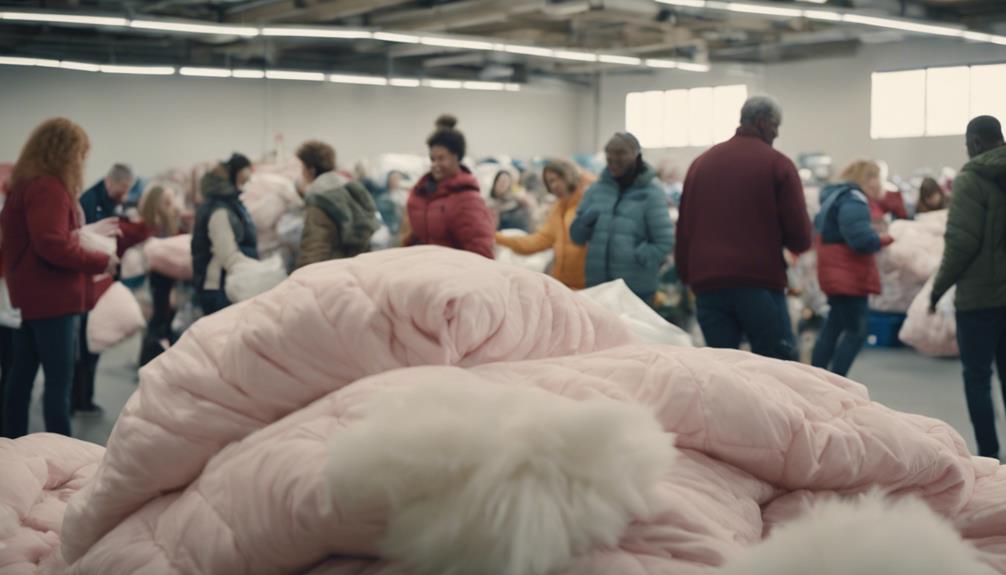
Nationwide, we can easily donate comforters to various organizations that accept bedding and textiles for donation, such as the American Red Cross GreenDrop program, Salvation Army, and Goodwill. When considering where to donate bedding or clothes, it's crucial to make sure that the items are gently used and in good condition. These donation centers welcome household goods, including old sheets and towels, to assist those in need.
It's worth mentioning that charities nationwide typically can't accept mattresses or severely damaged comforters. By donating these items, not only are we decluttering our homes, but we're also contributing to a good cause. Additionally, many donation centers offer the convenience of drop-off locations or pick-up services, making the donation process even more accessible. Remember to keep track of your donations, as you may be eligible for a tax deduction, providing an extra incentive to donate to those in need.
Churches and Faith-Based Organizations

When considering where to donate gently used comforters, churches and faith-based organizations play an important role in providing warmth and comfort to those in need within their communities. Comforter donations to churches can make a significant difference in the lives of individuals facing homelessness or difficult circumstances. Many churches distribute these donated comforters to families, individuals, and shelters to make sure that those without adequate bedding receive the support they need.
Homeless Shelters

Donating a comforter to a homeless shelter can directly impact someone in need by providing warmth and comfort during cold weather. Homeless shelters often rely on donations of comforters to help meet the basic needs of their residents. By donating a clean and gently used comforter, you can help support individuals experiencing homelessness by offering them a warm bed in a sheltered environment. These donations play an important role in creating a safe and comfortable space for those seeking refuge.
Comforters are appreciated by homeless shelters for their ability to provide warmth and a sense of security to residents facing harsh living conditions. When considering donating to a homeless shelter, reach out to local shelters in your community to inquire about their specific needs and donation guidelines. Your contribution can make a meaningful difference in the lives of those who are without a permanent home. By supporting homeless shelters with comforter donations, you're helping to make sure that individuals in need have access to essential warmth and comfort.
Animal Shelters
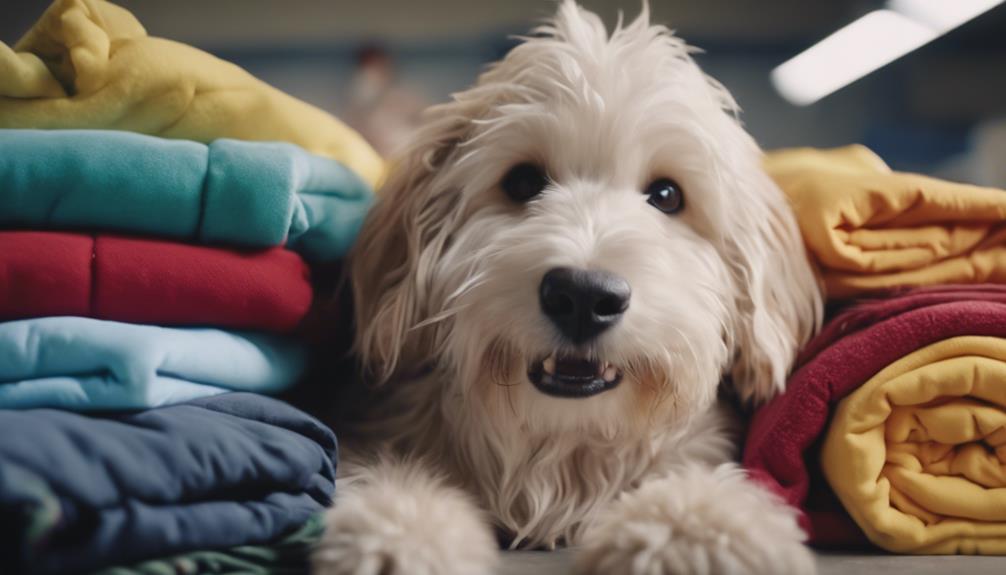
When considering donating comforters to animal shelters, it's crucial to understand the shelter's specific needs and the process for making donations.
Providing clean and gently used comforters can greatly benefit shelter animals by offering them warmth and comfort while they await adoption.
Shelter Needs
At animal shelters, comforters play a vital role in providing warmth and comfort to shelter animals. These cozy bedding essentials help create a comfortable environment for homeless pets awaiting their forever homes. When you donate clean and gently used comforters to animal shelters, you're contributing to the well-being and contentment of shelter animals.
Your contribution of comforters can make a significant difference in the lives of these animals, offering them a soft place to rest and feel secure. By providing comforters for shelter animals, you help guarantee that they've a warm and inviting space while they wait for adoption.
Your support in donating comforters to animal shelters is greatly appreciated and valued.
Donation Process
As we consider the process of contributing comforters to animal shelters, it's important to understand how these donations directly impact the well-being of shelter animals. When you donate comforters to animal shelters, you're helping to create a cozy environment for the animals awaiting their forever homes.
Here are some key points to keep in mind during the donation process:
- Your donation of clean and gently used comforters can provide warmth and comfort to shelter animals.
- Comforters play an essential role in keeping animals cozy and at ease during their stay at the shelter.
- Donated comforters can be repurposed as bedding or for various animal care needs within the shelters.
- Contributing comforters to animal shelters assists in enhancing the overall comfort and well-being of the rescued animals.
Salvation Army and Goodwill
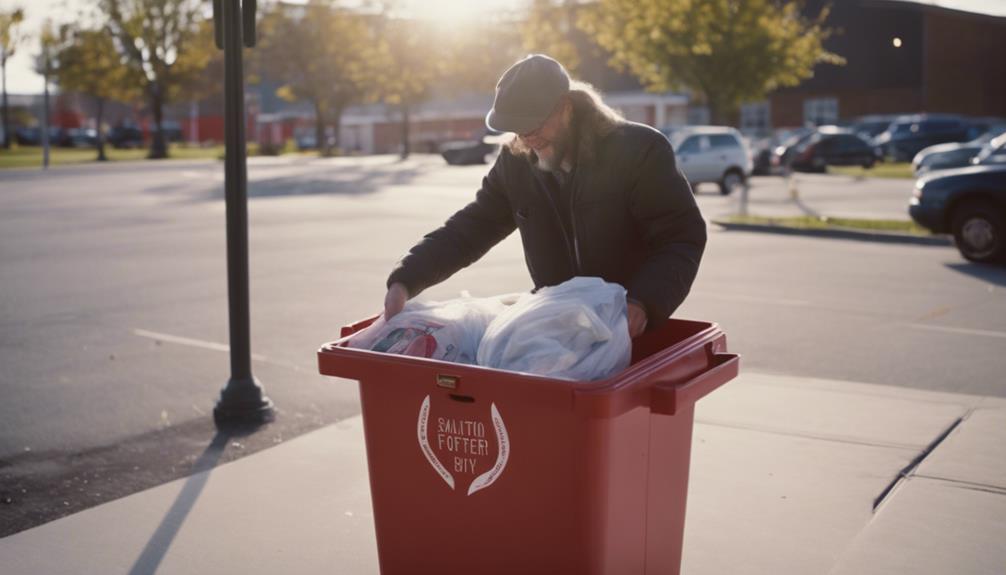
At Salvation Army and Goodwill, you can locate convenient drop-off locations for donating comforters. Make sure your comforter is in good condition before giving it to support their community initiatives and employment training programs.
The donation process is straightforward and impactful, contributing to both environmental sustainability and social welfare.
Donation Locations
Donating gently used comforters to the Salvation Army and Goodwill is a simple way to support those in need and contribute to their charitable programs. When looking to donate, consider the following about these donation locations:
- Both Salvation Army and Goodwill are reputable donation centers.
- They offer convenient drop-off locations for your comforter donations.
- Pick-up services are available for larger items, making it easier for you to donate.
- Your donations help fund various charitable programs and services in the community.
Acceptable Comforter Conditions
When donating comforters to Salvation Army and Goodwill, make sure they're clean and in good condition without rips, stains, or odors. Both organizations accept gently used comforters that are free of any damage or unpleasant smells.
Ensuring your comforters meet these essential conditions is vital for your donation to be utilized effectively for those in need. Ripped or stained comforters may not be accepted, as these flaws can limit the reusability of the items.
Donation Process
To donate comforters to Salvation Army and Goodwill, simply visit their drop-off locations or schedule a pick-up service for convenience. Make sure the comforters are clean and in good condition to support their reuse.
Here are some steps to facilitate your donations:
- Check the Salvation Army website for drop-off locations near you.
- Contact Goodwill to inquire about their donation process and pick-up services.
- Wash and fold the comforters neatly before donating to guarantee they're ready for reuse.
- Consider donating other items along with the comforters to maximize your impact on community services and employment training programs.
Environmental Recycling Programs

In our efforts to promote sustainability, exploring environmental recycling programs offers a practical solution for donating old comforters. Organizations like TerraCycle and American Textile Recycling Service specialize in textile recycling, including repurposing comforters to reduce waste and support environmental sustainability. TerraCycle utilizes Zero Waste Boxes to streamline the recycling process for comforters and other textiles. On the other hand, American Textile Recycling Service has convenient drop-off bins scattered across the United States, making it easy for individuals to recycle their old comforters responsibly. By participating in these recycling programs, you can contribute to the circular economy by giving your comforters a new life instead of letting them end up in landfills. Check out the table below for a quick overview of these environmental recycling programs:
| Recycling Program | Key Features |
|---|---|
| TerraCycle | Utilizes Zero Waste Boxes for easy recycling |
| American Textile Recycling Service | Provides drop-off bins across the U.S. |
Local Community Centers

Community centers in your area gladly accept comforter donations to assist individuals and families in need. Donating comforters to these local community centers can make a significant impact on someone seeking warmth and comfort during challenging times.
Here are some reasons why donating comforters to community centers is beneficial:
- Warmth and Comfort: Your donation can provide much-needed warmth and comfort to those facing hardship.
- Serve Clients: Community centers rely on donations like comforters to effectively serve their clients in need.
- Direct Impact: By donating a comforter, you can directly impact someone in your local community and make a positive difference in their life.
- Supporting Individuals in Need: Your contribution helps support individuals in need within your community, ensuring they have essential items for a better quality of life.
Consider reaching out to your local community center to inquire about their specific donation guidelines and how you can contribute to helping those in need.
Frequently Asked Questions
How Do I Donate Used Bedding?
To donate used bedding, clean and repair it first. Check requirements with donation organizations. Local shelters, Goodwill, and Salvation Army accept comforter donations.
Consider recycling at textile centers like American Textile Recycling Service. Repurpose old comforters into quilts or DIY projects.
Always make sure items are in good condition for donation.
Should I Wash a Comforter Before Donating?
Yes, washing a comforter before donating is crucial. It guarantees cleanliness and removes dirt, allergens, and odors.
Clean comforters are more likely to be accepted by donation centers and show consideration for the recipient's well-being. By washing the comforter, you contribute to a positive donation experience and help maintain the quality of donated items.
It's a simple step that can make a big difference in someone else's comfort and hygiene.
Do Salvation Army Take Bedding?
Yes, the Salvation Army does accept bedding donations, including comforters. Donated comforters should be clean, in good condition, and free of stains or tears.
Giving bedding to the Salvation Army supports their programs for those in need. It's a great way to give back to the community.
For specific guidelines on bedding donations, reach out to your local Salvation Army location.
What Items Does Purple Heart Not Accept?
Purple Heart doesn't accept items like mattresses, box springs, pianos, organs, waterbeds, large appliances, carpeting, built-in fixtures, ammunition, or hazardous materials.
Additionally, they don't take used tires, automotive parts, construction materials, or large exercise equipment.
Furthermore, the organization doesn't welcome food, open containers, perishable items, or broken, soiled, or repair-needed items.
Cribs, car seats, walkers, and baby items are also not suitable for Purple Heart donations.
Is it possible to donate a down comforter, and if so, where can I do so?
Yes, it is possible to donate down comforters. Many shelters, thrift stores, and charity organizations accept gently used down comforters. You can also check with local animal shelters, as they often accept down comforters for bedding. For more information, check out this donate down comforters article.
Conclusion
So, if you're looking to donate your comforter, there are plenty of options available.
Did you know that in the United States alone, over 550,000 people experience homelessness on any given night?
By donating your comforter to a local shelter, you can help provide warmth and comfort to those in need.
Consider reaching out to one of the organizations mentioned in this article to make a difference in someone's life today.
Comforter
How Long Does It Take a Down Comforter to Fluff up
Wondering how long it takes for a down comforter to fluff up? Discover the key to achieving ultimate loftiness and comfort.
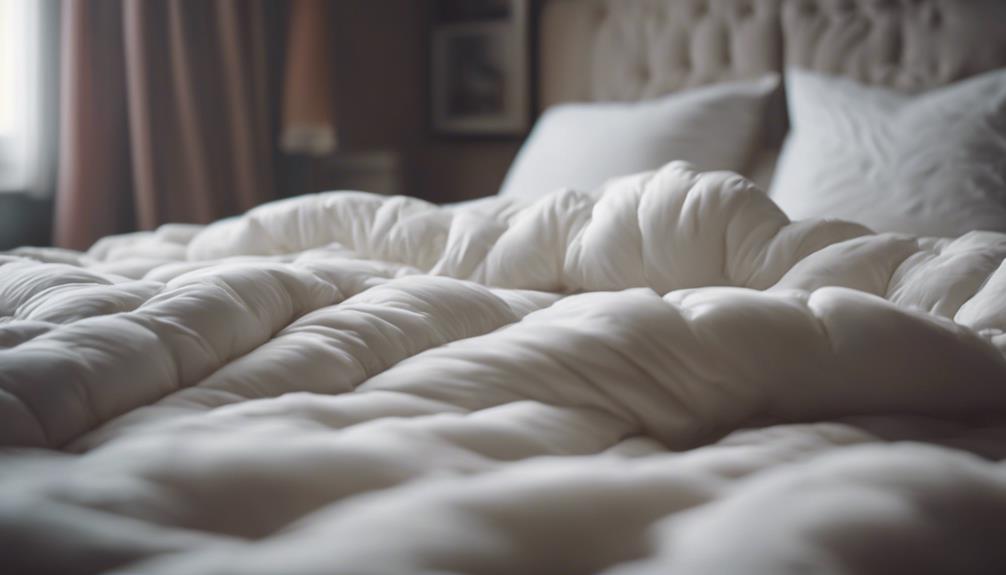
When waiting for a down comforter to fluff up, it usually takes a few hours if left on the bed. To speed up the process, try daily shaking and airing. These activities can help restore the loftiness of the comforter. Patience is key, as some comforters may continue to gain loft for up to two weeks. If your comforter still doesn’t feel fluffy, replacement might be necessary. Proper care and maintenance are also important for quick fluffing. Keep up the routine for best results and loftiness. Additional insights await for enhancing your down comforter’s fluffiness.
Key Takeaways
- Daily shaking and airing aid in loftiness restoration.
- New comforters may take hours to fully fluff up.
- Continued loft gain possible for up to two weeks.
- Replacement consideration if persistent flatness persists.
- Proper care accelerates the down comforter fluffing process.
Factors Affecting Fluffing Time
Factors affecting the time it takes for a down comforter to fluff up can include the quality of the down fill, the thickness of the comforter shell, and the frequency of shaking and airing.
When dealing with a new down comforter, it's important to allow time for the down to settle and expand properly. One way to speed up this process is by using a wool dryer on a no-heat or air fluff setting. Placing the comforter in the dryer with a few wool dryer balls can help fluff up the down clusters. However, it's vital to check the manufacturer's instructions first to make sure this method is safe for your specific comforter.
Additionally, regularly shaking and airing out the comforter can also aid in enhancing its loftiness. By incorporating these practices, you can help your new down comforter reach its full fluff potential in a shorter amount of time.
Sunlight Vs. Dryer Method
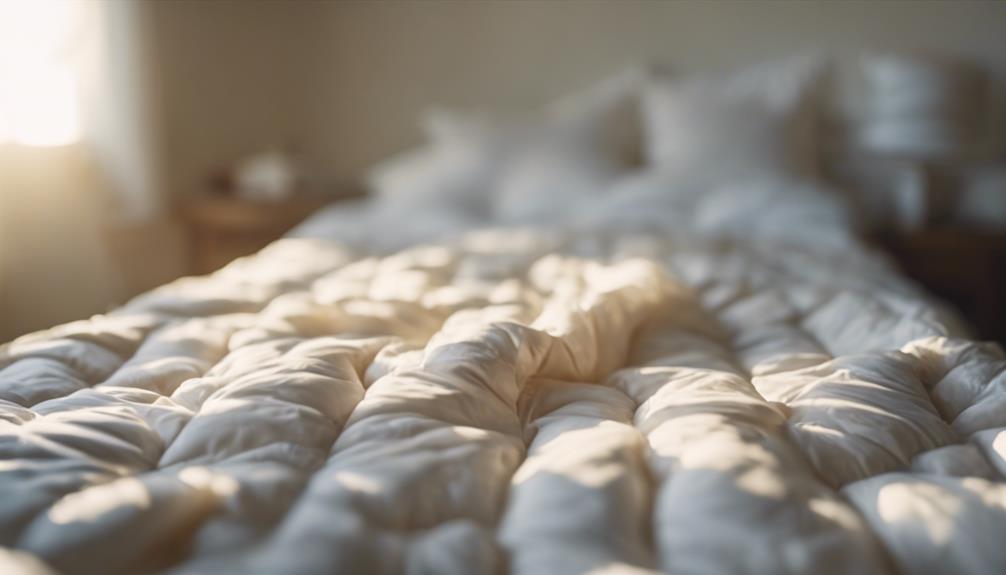
To enhance the fluffiness of a down comforter, one can opt for either the sunlight method or the dryer method with tennis balls. The sunlight method involves hanging the comforter outside for a day to invigorate it and help fluff up the down filling. Exposure to sunlight helps eliminate odors, bacteria, and can improve the loftiness of the comforter. Sunlight is effective for revitalizing comforters and pillows, recommended to leave them outside overnight for best results.
On the other hand, the dryer method with tennis balls includes washing the comforter and drying it with clean tennis balls to prevent clumping and fluff up the comforter. Using tennis balls in the dryer helps maintain the loftiness of the comforter by evenly distributing the down filling during the drying process. Both methods are effective in their ways, with the choice depending on personal preference and convenience.
Impact of Temperature Variations

Temperature fluctuations play an essential role in influencing how quickly a down comforter fluffs up. Warmer temperatures can assist the down feathers in expanding and regaining loft more rapidly, expediting the fluffing process. Conversely, colder temperatures may slow down this process, requiring more time for the down comforter to achieve full fluffiness.
Important temperature conditions are vital for enhancing the efficiency of the fluffing up of a down comforter. It's vital to contemplate the ambient temperature in the room where the down comforter is placed to ensure the best results. By selecting a suitable temperature environment, one can positively impact the time it takes for a down comforter to fluff up effectively.
Thus, paying attention to temperature variations is key in facilitating the fluffing process and optimizing the performance of a down comforter.
Understanding Down Filling Behavior

As we explore down filling behavior, it becomes evident that the initial flat appearance of a new down comforter is a common occurrence due to compression during shipping. When a comforter is tightly packed for delivery, the down filling gets squished, reducing its fluffiness.
However, over a few hours on the bed, the down filling will naturally regain its loft and fluffiness as it expands and adjusts to the environment. To expedite this process, daily shaking of the comforter can help redistribute the fill and enhance its loft.
Some new comforters continue to gain loft and fluffiness for up to two weeks after unboxing. If a new down comforter doesn't improve in loftiness over time, it may be a sign to contemplate replacing it to make sure you get the desired level of comfort and warmth.
Understanding how down filling behaves can assist you in maximizing your comforter's fluffiness and longevity.
Patience and Fluffing Expectations

When considering the fluffing process of a down comforter, it's important to manage our expectations.
Understanding the time frame for fluffing, various techniques to enhance loftiness, and the expected results can help us appreciate the progress.
Patience is key as we allow the down comforter to reach its fullest fluffiness potential.
Fluffing Time Frame
Let's discuss the timeframe required for a down comforter to fluff up, emphasizing the need for patience and realistic fluffing expectations. A new down comforter may seem flat initially, but it typically starts regaining its loft after a few hours on the bed. Daily shaking of the comforter can help redistribute the fill and enhance its fluffiness. Some new comforters continue to gain loft for up to two weeks as the down settles and expands. If your comforter doesn't show improved loftiness after this period, it might be time to contemplate a replacement. Proper care, such as shaking and airing out, can maintain and enhance the fluffiness of a down comforter over time.
| Fluffing Time Frame | Expectations |
|---|---|
| Few hours | Initial fluffiness returns |
| Up to two weeks | Continual gain in loft |
| No improvement | Contemplate replacement |
| Proper care | Maintains and enhances fluffiness |
Fluffing Techniques
Exploring effective fluffing techniques for down comforters underscores the importance of patience and managing fluffing expectations.
When using a dryer, it's vital to set it on a low heat setting and add a couple of clean tennis balls to help fluff up the comforter. Remember, the process can take a few cycles to reach the desired level of fluffiness.
Daily shaking and airing out the comforter can also aid in redistributing the down fill and enhancing its loft. It's important to understand that some down comforters may continue to gain loft for up to two weeks as the down settles and fluffs up.
Fluffing Results
As we observe the results of fluffing a down comforter, it becomes evident that patience plays a key role in managing our expectations for achieving peak loftiness. After fluffing, the comforter may still appear flat, but with time and proper care, it will regain its full loft. Regular shaking and airing out the comforter can help maintain its fluffiness. Additionally, using a duvet cover can protect the comforter and assist in preserving its loft over time. For a quick fluff boost, tossing the comforter in the dryer on the air fluff setting can help restore its puffiness. Remember, consistent care and a bit of patience are essential for keeping your down comforter fluffy and cozy.
| Fluffing Results | Tips for Maintaining Fluffiness |
|---|---|
| Initial flatness | Allow time for loft to return |
| Regular shaking | Redistribute fill for loft |
| Air fluff setting | Quick boost for puffiness |
Realistic Fluffing Timeframes

For a new down comforter, it typically takes a few hours on the bed to fluff up and regain its loft. Here are some realistic fluffing timeframes to keep in mind:
- Initial Fluffing: Expect your new down comforter to look flat upon unpacking. Allow it some time on your bed to naturally fluff up and reach its full loftiness potential.
- Daily Shaking: To expedite the fluffing process, shake your comforter daily. This action helps redistribute the down fill evenly, enhancing its loft and overall comfort.
- Continued Fluffing: Some down comforters may continue to gain loft for up to two weeks as the down settles. Be patient and give it time to reach its maximum fluffiness.
- Replacement Consideration: If your new comforter doesn't show significant improvement in loftiness over time, it may be worth considering a replacement. A good down comforter should fluff up and maintain its loft with proper care.
Monitoring Fluffing Progress
When monitoring the fluffing progress of a down comforter, it's important to observe how the fill redistributes over time.
Daily shaking and airing out the comforter can aid in enhancing its loftiness.
Fluffing Timeframes
Monitoring the progress of fluffing a down comforter involves observing how it regains loftiness over time. Here are some key points to keep in mind when monitoring the fluffing timeframes:
- A new down comforter may take a few hours to fully fluff up on the bed.
- Daily shaking and airing out can help the down comforter regain its loftiness.
- Some down comforters continue to gain loft for up to two weeks after unboxing.
- If a new comforter doesn't fluff up within the expected timeframe, contemplate replacing it.
Proper care and maintenance play an important role in expediting the fluffing process of a down comforter.
Fluffing Techniques
To effectively gauge the progress of fluffing a down comforter, a consistent routine of shaking and airing out is essential. Daily shaking helps redistribute the fill inside, enhancing the comforter's loft and fluffiness.
By gently shaking the comforter and allowing it to breathe, you can monitor its progress in regaining its fullness. Remember, some new comforters may continue to gain loft for up to two weeks after unpacking.
If your comforter doesn't regain its fluffiness over time, it might be time to contemplate replacing it. Proper care, including regular shaking and airing out, is key to maintaining and improving the fluffiness of your down comforter.
Frequently Asked Questions
Why Isn't My Down Comforter Fluffy?
If your down comforter isn't fluffy, it may need time to expand after being compressed. Regular shaking and gentle fluffing can help speed up the process. Factors like the down filling type and fabric quality can influence how quickly it fluffs up.
If it stays flat for too long, it might be due to low-quality materials or construction. Give it some time and care, and it should fluff up nicely.
How to Make Your Down Comforter Fluffy Again?
To make your down comforter fluffy again, try daily shaking and airing it out to redistribute the fill and enhance loft. This process can take a few hours to a couple of weeks, depending on the comforter.
If the loft doesn't return, it may be time to replace it. Remember, gentle use, proper washing, and storage are key to maintaining the fluffiness of your down comforter.
Can Down Comforter Go in the Dryer?
Yes, down comforters can go in the dryer on a low heat setting. Using dryer balls helps distribute the down filling evenly. Avoid high heat to prevent damage.
Regularly fluff and dry the comforter to maintain loftiness. Follow the manufacturer's care instructions for safe drying.
It's important to take proper care of your comforter for long-lasting fluffiness.
What to Do When You First Get a Down Comforter?
When you first get a down comforter, it may seem flat initially. To help it fluff up, shake and fluff it daily. This will redistribute the fill and enhance its loftiness.
Some new comforters can take up to two weeks to fully fluff up as the down settles. If your comforter doesn't improve even with care and time, consider replacing it for best comfort and warmth.
– Does the fluffiness of a down comforter affect its safety for toddlers?
When it comes to down comforters for toddlers safety, the level of fluffiness can impact their safety. A down comforter that is too fluffy can potentially pose a suffocation risk for young children. It’s crucial to carefully consider the fluffiness and overall design of the comforter to ensure a safe sleeping environment.
Conclusion
To sum up, the time it takes for a down comforter to fluff up can vary depending on factors like filling type and drying method.
While some may expect instant results, it's important to be patient and understand that fluffing takes time.
By monitoring progress and adjusting methods as needed, you can achieve the desired fluffiness in a realistic timeframe.
Remember, good things come to those who wait and take the time to care for their bedding properly.
Mason – Your Product Expert Mason is your go-to product expert, carefully selecting each item in our collection to ensure it meets your comfort, functionality, and style needs. With his attention to detail and commitment to quality, he ensures that every product we offer enhances your home experience.
-
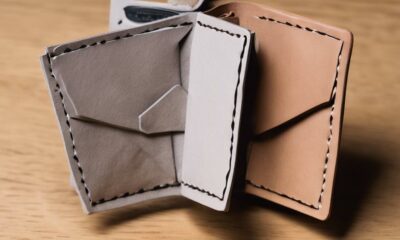
 Vetted6 months ago
Vetted6 months ago14 Best Personalized Father's Day Gifts for Your Husband – Show Him You Care
-

 Alfresco6 months ago
Alfresco6 months agoAlfresco Stacker Doors: Seamless Indoor-Outdoor Living!
-

 Vetted7 months ago
Vetted7 months ago15 Best EMS Foot Massagers for Neuropathy to Soothe Your Feet
-

 Craft and Textiles7 months ago
Craft and Textiles7 months ago15 Best Places to Buy Appliances for Your Home – Top Retailers Reviewed
-

 Tableware and Dining Accessories7 months ago
Tableware and Dining Accessories7 months agoWhat Is the Meaning of the Word Tableware
-
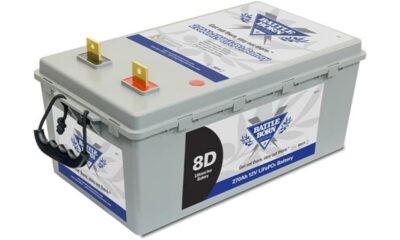
 Vetted5 months ago
Vetted5 months agoBattle Born Batteries Review: Reliable Power Solution
-

 Vetted5 months ago
Vetted5 months agoD-Link Switch Review: Lite Layer 3 Managed Networking
-

 Tableware and Dining Accessories7 months ago
Tableware and Dining Accessories7 months agoWhen Is Tableware on Sale at Hobby Lobby





























